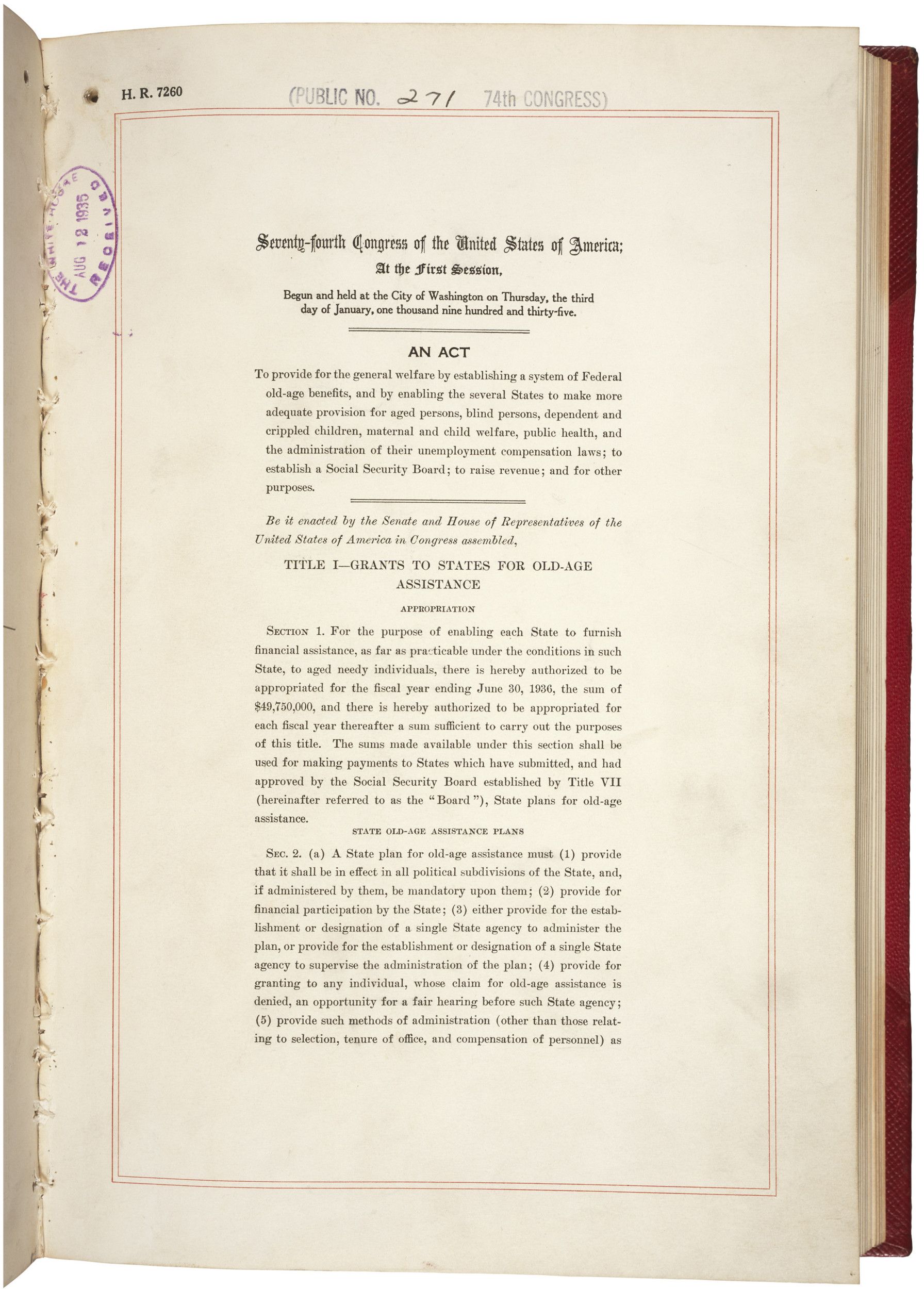Social Security Act
8/14/1935
Add to Favorites:
Add all page(s) of this document to activity:

The Social Security Act established a system of old-age benefits for workers, benefits for victims of industrial accidents, unemployment insurance, and aid for dependent mothers and children, persons who are blind, and persons with disabilities.
Before the 1930s, support for the elderly was a matter of local, state, and family concern rather than a federal concern (except for veterans’ pensions). However, the widespread suffering experienced during the Great Depression elicited congressional support for numerous proposals for a national old-age insurance system.
On January 17, 1935, President Franklin D. Roosevelt sent a message to Congress asking for "social security" legislation. The same day, Senator Robert Wagner of New York and Representative David Lewis of Maryland introduced bills reflecting the administration’s views. The resulting Senate and House bills encountered opposition from those who considered it governmental overreach into the private sphere, as well as from those who didn't want employers to have to pay additional taxes. Eventually a compromise bill passed both houses, and on August 15, 1935, President Roosevelt signed the Social Security Act into law.
The act created a uniquely American solution to the problem of old-age pensions. Unlike many European nations, U.S. social security "insurance" was supported from "contributions" in the form of taxes on individuals’ wages and employers’ payrolls rather than directly from government funds.
The act also provided funds to assist children, the blind, and the unemployed; institute vocational training programs; and provide family health programs. As a result, enactment of Social Security brought into existence complex administrative challenges. The Social Security Act authorized the Social Security Board to register citizens for benefits, administer the contributions received by the federal government, and send payments to recipients.
Before the 1930s, support for the elderly was a matter of local, state, and family concern rather than a federal concern (except for veterans’ pensions). However, the widespread suffering experienced during the Great Depression elicited congressional support for numerous proposals for a national old-age insurance system.
On January 17, 1935, President Franklin D. Roosevelt sent a message to Congress asking for "social security" legislation. The same day, Senator Robert Wagner of New York and Representative David Lewis of Maryland introduced bills reflecting the administration’s views. The resulting Senate and House bills encountered opposition from those who considered it governmental overreach into the private sphere, as well as from those who didn't want employers to have to pay additional taxes. Eventually a compromise bill passed both houses, and on August 15, 1935, President Roosevelt signed the Social Security Act into law.
The act created a uniquely American solution to the problem of old-age pensions. Unlike many European nations, U.S. social security "insurance" was supported from "contributions" in the form of taxes on individuals’ wages and employers’ payrolls rather than directly from government funds.
The act also provided funds to assist children, the blind, and the unemployed; institute vocational training programs; and provide family health programs. As a result, enactment of Social Security brought into existence complex administrative challenges. The Social Security Act authorized the Social Security Board to register citizens for benefits, administer the contributions received by the federal government, and send payments to recipients.
Transcript
AN ACT to provide for the general welfare by establishing a system of Federal old-age benefits, and by enabling the several States to make more adequate provision for aged persons, blind persons, dependent and crippled children, maternal and child welfare, public health, and the administration of their unemployment compensation laws; to establish a Social Security Board; to raise revenue; and for other purposes.Be it enacted by the Senate and House of Representatives of the United States of America in Congress assembled,
TITLE I- GRANTS TO STATES FOR OLD-AGE ASSISTANCE
APPROPRIATION
SECTION 1. For the purpose of enabling each State to furnish financial assistance, as far as practicable under the conditions in such State, to aged needy individuals, there is hereby authorized to be appropriated for the fiscal year ended June 30, 1936, the sum of $49,750,000, and there is hereby authorized to be appropriated for each fiscal year thereafter a sum sufficient to carry out the purposes of this title. The sums made available under this section shall be used for making payments to States which have submitted, and had approved by the Social Security Board established by Title VII (hereinafter referred to as the Board ), State plans for old-age assistance.
STATE OLD-AGE ASSISTANCE PLANS
SEC. 2. (a) A State plan for old-age assistance must
(1) provide that it shall be in effect in all political subdivisions of the State, and, if administered by them, be mandatory upon them;
(2) provide for financial participation by the State;
(3) either provide for the establishment or designation of a single State agency to administer the plan, or provide for the establishment or designation of a single State agency to supervise the administration of the plan;
(4) provide for granting to any individual, whose claim for old-age assistance is denied, an opportunity for a fair hearing before such State agency;
(5) provide such methods of administration (other than those relating to selection, tenure of office, and compensation of personnel) as ...
This primary source comes from the General Records of the United States Government.
National Archives Identifier: 596382
Full Citation: Social Security Act; 8/14/1935; Enrolled Acts and Resolutions of Congress, 1789 - 2011; General Records of the United States Government, Record Group 11; National Archives Building, Washington, DC. [Online Version, https://docsteach.org/documents/document/social-security-act, April 25, 2024]Activities that use this document
- The New Deal: Revolution or Reform?
Created by the National Archives Education Team
Rights: Public Domain, Free of Known Copyright Restrictions. Learn more on our privacy and legal page.



